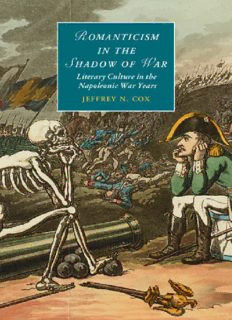
Romanticism in the Shadow of War: Literary Culture in the Napoleonic War Years PDF
Preview Romanticism in the Shadow of War: Literary Culture in the Napoleonic War Years
ROMANTICISM IN THE SHADOW OF WAR JeffreyN.CoxreconsidersthehistoryofBritishRomanticism,seeing theworkofByron,theShelleys,andKeatsrespondingnotonlytothe “first-generation” Romantics led by Wordsworth, but more directly totheculturalinnovationsoftheNapoleonicWaryears.Recreating indepththreemomentsofpoliticalcrisisandculturalcreativity–the PeaceofAmiens,theRegencyCrisis,andNapoleon’sfirstabdication– Coxshowshow“second-generation”Romanticismdrewoncultural “borderraids,”seekingaglobalcultureatatimeofglobalwar.This book explores how the introduction on the London stage of melo- drama in 1803 shaped Romantic drama, how Barbauld’s prophetic satire Eighteen Hundred and Eleven prepares for the work of the Shelleys,andhowHunt’scontroversialStoryofRiminishowedyounger writers how to draw on the Italian cultural archive. Responding to worldwar,thesewriterssoughttoembracearadicallynewvisionof theworld. jeffrey n. cox isProfessorofEnglish,ofComparativeLiterature, andofHumanitiesattheUniversityofColoradoBoulder,wherehe is also the Vice Provost and Associate Vice Chancellor for Faculty Affairs. He is author of Poetry and Politics in the Cockney School: Shelley, Keats, Hunt, and their Circle (Cambridge, 1998) and In the Shadows of Romance: Romantic Tragic Drama in Germany, England, andFrance(1987). cambridge studies in romanticism Foundingeditor professor marilynbutler,UniversityofOxford Generaleditor professor jameschandler, UniversityofChicago EditorialBoard johnbarrell, UniversityofYork paulhamilton,UniversityofLondon maryjacobus,UniversityofCambridge claudiajohnson,PrincetonUniversity alanliu,UniversityofCalifornia,SantaBarbara jeromemcgann,UniversityofVirginia davidsimpson,UniversityofCalifornia,Davis This series aims to foster the best new work in one of the most challenging fields within English literary studies. From the early 1780s to the early 1830s a formidable array of talented men and women took to literary composition, not just in poetry, which some of them famously transformed, but in many modes of writing. The expansion of publishing created new opportunities for writers, and the political stakes of what they wrote were raised again by what Wordsworth called those “great national events” that were “almost daily taking place”:theFrenchRevolution,theNapoleonicandAmericanwars,urbanization, industrialization, religious revival, an expanded empire abroad, and the reform movement at home. This was an enormous ambition, even when it pretended otherwise.Therelationsbetweenscience,philosophy,religion,andliteraturewere reworkedintextssuchasFrankensteinandBiographiaLiteraria;genderrelations in A Vindication of the Rights of Woman and Don Juan; journalism by Cobbett andHazlitt;poeticform,content,andstylebytheLakeSchoolandtheCockney School.OutsideShakespearestudies,probablynobodyofwritinghasproduced such a wealth of comment or done so much to shape the responses of modern criticism. This indeed is the period that saw the emergence of those notions of “literature” and of literary history, especially national literary history, on which modernscholarshipinEnglishhasbeenfounded. ThecategoriesproducedbyRomanticismhavealsobeenchallengedbyrecent historicistarguments.Thetaskoftheseriesistoengagebothwithachallenging corpus of Romantic writings and with the changing field of criticism they have helped to shape. As with other literary series published by Cambridge, this one willrepresenttheworkofbothyoungerandmoreestablishedscholars,oneither sideoftheAtlanticandelsewhere. For a complete list of titles published see end of book. ROMANTICISM IN THE SHADOW OF WAR Literary Culture in the Napoleonic War Years JEFFREY N. COX UniversityPrintingHouse,Cambridgecb28bs,UnitedKingdom CambridgeUniversityPressispartoftheUniversityofCambridge. ItfurtherstheUniversity’smissionbydisseminatingknowledgeinthepursuitof education,learningandresearchatthehighestinternationallevelsofexcellence. www.cambridge.org Informationonthistitle:www.cambridge.org/9781107071940 ©JeffreyN.Cox2014 Thispublicationisincopyright.Subjecttostatutoryexception andtotheprovisionsofrelevantcollectivelicensingagreements, noreproductionofanypartmaytakeplacewithoutthewritten permissionofCambridgeUniversityPress. Firstpublished2014 PrintedintheUnitedKingdombyClays,StIvesplc AcatalogrecordforthispublicationisavailablefromtheBritishLibrary. LibraryofCongressCataloginginPublicationdata isbn978-1-107-07194-0Hardback CambridgeUniversityPresshasnoresponsibilityforthepersistenceoraccuracyof urlsforexternalorthird-partyinternetwebsitesreferredtointhispublication, anddoesnotguaranteethatanycontentonsuchwebsitesis,orwillremain, accurateorappropriate. Inmemoriam KennethA.Cox JaneMoody Contents Acknowledgments pageviii Listofabbreviations xi Introduction:Borderraidsasculturalpractice 1 1 Holcroft’sParisianexpedition 25 2 Afterwar:Manfredandthemelodrama 59 3 Barbauld’ssallies 93 4 Lovebeyondfaithandhope:PercyandMaryShelleyonhistory andprophecy 126 5 TheimportofHunt’s“Italianism” 160 6 CockneysinTuscany 188 Notes 217 Selectbibliography 248 Index 267 vii Acknowledgments This project began as an invited talk at the 2004 meeting of the Inter- national Conference on Romanticism held at Texas A&M International in Laredo on “Romantic Border Crossings.” I want to thank ICR, the conferenceorganizers,andaboveallJeffreyCassforprovidingtheimpetus tobeginthinkingabouttheissuesIengagehere.Thecolleagueswhowere thereandthebordersiteitselfmadethisameetingtoremember. The first actual audience for these ideas was Dana Van Kooy, Terry Robinson,andJenniferJones,whoweregoodenoughtolistentoapractice versionoftheICRtalk.OneofthelastaudiencesforthebookwasMichele Speitz,whoofferedadviceonfinalrevisions.Theywerealloncegraduate studentsorpost-doctoralfellowsattheUniversityofColoradoBoulderand arenowcolleagueswhoseownworkinspiresmineandgivesmeasenseof where Romanticism as a field is headed. I owe a great debt to them and to other fine Colorado graduate students, former and current, including JohnLeffel,KurtisHessel,ScottHagele,PriyaJha,DanielLarson,Kirstyn Leuner,DevenParker,andJimWalker. Thisprojecthasgrownwithinaseriesofintellectualcommunities.Most immediately are my colleagues in the Colorado Romanticism Collective and its core members, Jill Heydt-Stevenson (who sees into the “life of things”),PadmaRangarajan(“seemedmadetoshew/Howfarthegenuine flesh and blood could go”), John Stevenson (“Philosophy like thine turns topuregold/Earth’sdross”),andPaulYoungquist(“Whois,whatothers seem” and who acts upon the commited, collective Romanticism others talk about). Through daily acts of friendship and through career-long scholarly accomplishments, their efforts make mine possible. These are the local representatives of a larger gathering of Romanticists who care for each other and create new knowledge, who have welcomed me and my students into the profession, and who have created the warmth of communityamidstwhatcanbecoldprofessionalism.Icannotnamethem all,butasrepresentativesoftherest:MarkLussier,GregKucich,Michael viii
Description: